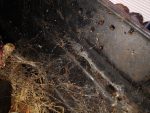This is exciting. I’ve written about my compost bin before, which has been a rich source of spider lore — a partially closed habitat, the domain of some large dark spiders that build their cobwebs in a place rife with buzzing insects.
The bin has been inaccessible for months, buried under snow. Today the snow had retreated enough that we could hobble over slick, crunchy ice to get to it and throw back the lid. What did I see?
First, fresh silk, new cobwebs laid across the corners. Somebody had been working hard. Then, suddenly, at one side, a massive spider loomed out of the darkness — a fully grown, adult male Steatoda borealis. His presence tells me something: he’s much too large to be a recent hatchling, so he must have overwintered down in the dark, sheltered from the storms, huddled in the fermenting warmth of the compost.
We closed the lid and let him be. I’m sure there are more down there who will creep out in the next few weeks to rebuild a thriving colony.
If you want to see this massive unit of a tough Minnesota spider, you can go to Patreon or Instagram. He’s big and dark in shades of red and black with thick strong limbs and glowing eyes.



Probably for the best. If you let him out, he might slouch towards Bethlehem.
He? Big spiders are usually she spiders.
That’s kind of neat. We were excited to find that the herb growing on our compost bin was chervil. We’ve been trying to grow some for years but failed. Then, our compost heap came through.
Not really relevant, but interesting, social spiders in Madagascar:
https://entomologytoday.org/2023/03/30/isoxya-manangona-spiders-new-species-social-behavior/
I’m guessing you’ve read this already.
Sadly “The dark depths” are notoriously nutritient-poor. That is why there are no Cthonians, no elder races biding their time. Giant squids are an exception, but they are not that big in terms of body mass, not compared to delta crocodiles.
I wish there was an evolutionary pressure to make arthropods evolve proper lungs. That would make compost bins more interesting.
It’s a male. I should try to get a better photo of his palps, because borealis males have monstrous spiky palps.
An article on humans and spiders was in today’s Globe:
https://www.theglobeandmail.com/canada/article-spiders-are-stuck-in-a-web-of-misinformation-scientists-hope-to-free/
There is an attached youtube video on the yellow sac spider: